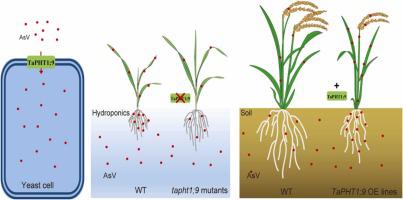Journal of Hazardous Materials ( IF 12.2 ) Pub Date : 2023-03-15 , DOI: 10.1016/j.jhazmat.2023.131219 Pengfei Wang 1 , Zedong Chen 1 , Yanjun Meng 1 , Huanting Shi 1 , Chuang Lou 1 , Xu Zheng 1 , Gezi Li 1 , Xiangnan Li 2 , Wanxi Peng 3 , Guozhang Kang 4

|
Arsenate (AsV) is one of the most common forms of arsenic (As) in environment and plant high-affinity phosphate transporters (PHT1s) are the primary plant AsV transporters. However, few PHT1s involved in AsV absorption have been identified in crops. In our previous study, TaPHT1;3, TaPHT1;6 and TaPHT1;9 were identified to function in phosphate absorption. Here, their AsV absorption capacities were evaluated using several experiments. Ectopic expression in yeast mutants indicated that TaPHT1;9 had the highest AsV absorption rates, followed by TaPHT1;6, while not for TaPHT1;3. Under AsV stress, further, BSMV-VIGS-mediated TaPHT1;9-silencing wheat plants exhibited higher AsV tolerance and lower As concentrations than TaPHT1;6-silenced plants, whereas TaPHT1;3-silencing plants had similar phenotype and AsV concentrations to control. These suggested that TaPHT1;9 and TaPHT1;6 possessed AsV absorption capacity with the former showing higher activities. Under hydroponic condition, furthermore, CRISPR-edited TaPHT1;9 wheat mutants showed the enhanced tolerance to AsV with decreased As distributions and concentrations, whereas TaPHT1;9 ectopic expression transgenic rice plants had the opposite results. Also, under AsV-contaminated soil condition, TaPHT1;9 transgenic rice plants exhibited depressed AsV tolerance with increased As concentrations in roots, straws and grains. Moreover, Pi addition alleviated the AsV toxicity. These suggested that TaPHT1;9 should be a candidate target gene for AsV phytoremediation.
中文翻译:

小麦 PHT1;9 作为植物修复的一种候选砷酸盐吸收转运蛋白
砷酸盐 (AsV) 是环境中最常见的砷 (As) 形式之一,植物高亲和力磷酸盐转运蛋白 (PHT1s) 是主要的植物 AsV 转运蛋白。然而,在农作物中很少发现参与 AsV 吸收的 PHT1。在我们之前的研究中,TaPHT1;3、TaPHT1;6 和 TaPHT1;9 被确定在磷酸盐吸收中发挥作用。在这里,使用几个实验评估了它们的 AsV 吸收能力。酵母突变体中的异位表达表明 TaPHT1;9 具有最高的 AsV 吸收率,其次是 TaPHT1;6,而 TaPHT1;3 则不是。此外,在 AsV 胁迫下,BSMV-VIGS 介导的TaPHT1;9沉默小麦植物表现出比TaPHT1;6沉默植物更高的 AsV 耐受性和更低的 As 浓度,而TaPHT1;3- 沉默植物具有相似的表型和 AsV 浓度以进行控制。这些表明 TaPHT1;9 和 TaPHT1;6 具有吸收 AsV 的能力,前者表现出更高的活性。此外,在水培条件下,CRISPR 编辑的TaPHT1;9小麦突变体显示出对 AsV 的耐受性增强,As 分布和浓度降低,而TaPHT1;9异位表达转基因水稻植物具有相反的结果。此外,在受 AsV 污染的土壤条件下,TaPHT1;9转基因水稻植物表现出较低的 AsV 耐受性,同时根部、秸秆和谷物中的 As 浓度增加。此外,Pi 的添加减轻了 AsV 的毒性。这些表明TaPHT1;9应该是 AsV 植物修复的候选靶基因。











































 京公网安备 11010802027423号
京公网安备 11010802027423号